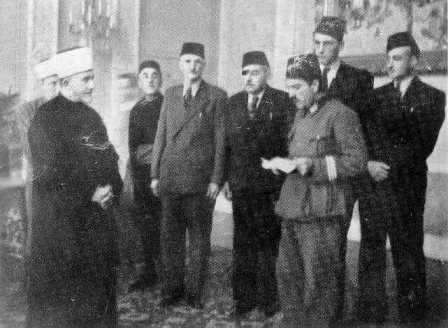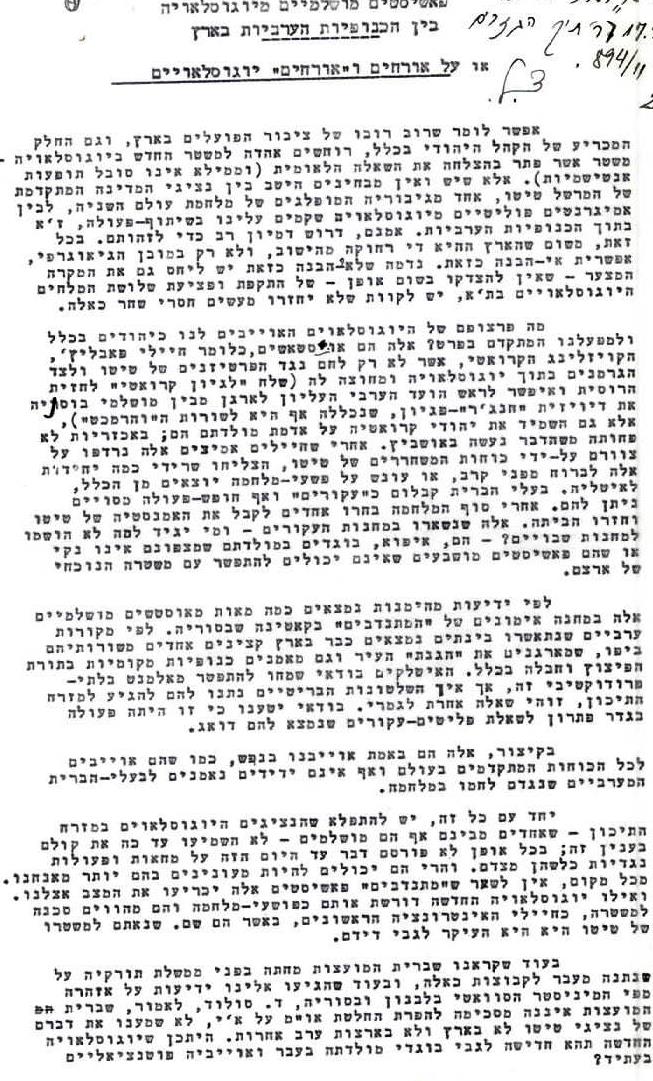During the 1948 War of Independence, the Jewish yishuv was greatly assisted by volunteers from abroad. More than 3000 volunteers entered the country and shared the military expertise they had acquired during World War II with the Jewish fighting forces.
The Arab side also benefited from European volunteers. The letter before you, from the Political Department of the Jewish Agency, deals with Yugoslavian Muslim volunteers of the fascist Ustasha movement, which came to the country in order to assist Arab fighters.
The red and the black
In 1941, Vladko Macek, head of the Croatian Peasant party, received a lucrative job offer: prime minister of Croatia. That year, Nazi forces invaded Yoguslavia, and were looking for an influential politician to head a new puppet regime in Croatia. But Macek was not the man for the job: he refused, and called for the citizens of Yuguslavia to resist the invaders. The Germans soon found another politician willing to jump on their wagon: Slavko Kvaternik, one of the leaders of the Ustasha movement. The Nazi-Ustasha alliance was based on the two elements that are imperative for successful, long lasting relationships: a mutual outlook on life, and similar aspirations.
The Ustasha movement was an ultra-nationalistic Catholic Croatian movement, founded in 1929. It aspired to separate from Yuguslavia and found an independent Croatian state. As a separatist movement that advocated violence, it was soon proscribed, which of course made it popular among incited Croatian youth, who were swept up in the waves of nationalism and fascism that washed over Europe in the 1930's. In the decade leading to WWII, the movement maintained a high profile by promoting underground propaganda, attempting a failed mutiny attempt, and by assisting in the assassination of the Yuguslavian monarch in 1934. Its main effort was in training its members in a clandestine paramilitary camp in Italy, in order to take Croatia by force. But this was deemed unnecessary – Croatia was given to the Ustasha without a fight.
Kvaternik happily accepted Hitler's offer, and on April 14th 1941, declared Croatia an independent state. The Ustasha quickly organized their forces into a military organization- the Black Legion. From that moment on, Yugoslavia was torn in a bloody internal dispute, between the "black" Ustasha legion, which by 1944 was 74,000 men strong, and General Tito's "red" forces.
The Ustasha regime was a unique phenomenon in Nazi Europe. This was the only case where a local organization took such an active part in Jewish genocide, and also initiated the attempted genocide of another people – the Serbs. The Ustasha founded extermination camps immediately with its ascendance to power, some of which were more notoriously cruel than those of the Nazis. 32,000 Jews were murdered in Ustasha-controlled areas, and 40,000 gypsies. The Serbs, which the Ustasha perceived as an obstacle in the way of a "pure" Croatia, were their main target. between 35,000 and 70,000 Serbs were murdered by the organization.

The Dagger division and Haj Amin al-Housseini
During their rule in Croatia, The Ustasha enabled the Nazis to train the 13th Waffen mountain division of the SS - the Handschar (dagger) infantry division. It was comprised of 21,000 Muslim fighters, mainly from Albania and Bosnia (parts of which were included in Ustashan Croatia). The Nazis resigned to using the grand Mufti of Jerusalem, Haj Amin al- Housseini, for recruitment purposes, after local imams refused to cooperate with them and even published fatwas prohibiting cooperation with Nazi forces. In the end of WWII, fighters from the Handschar mountain division fled to Italy, and some of them found themselves in Palestine in 1948, sharing their military education with fellow Muslims.
The letter before you deals with an attack by Jews on three Yoguslavian sea men, not affiliated with the Ustasha movement or the war in general. It begs to make a distinction, between hostile, Ustasha fighters, and innocent Yoguslavian foreigners that found themselves in the midst of a bloody dispute.
